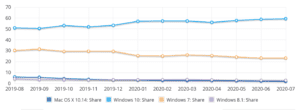IGEL Blog

Windows 7 Extended Support – a Ticking Time Bomb
The Clock Keeps Ticking and Costs are Just about to Double!
We all know that Windows 7 went end of life on Jan 14th, 2020. At the time Netmarketshare reported that around 30% of desktops were still running Windows 7. For those organizations not able to migrate off the 11-year-old OS, Microsoft offered to continue supporting these desktops through the Extended Security Update (ESU) program. Available as a one-year SKU, Microsoft would continue to patch known vulnerabilities for around $50 per device, depending on the version of Windows used (Windows E3 was about half that price and Windows E5 was free for year one).
Today the ESU program has proven to be an essential offering to many organizations who were still running Windows 7, but perhaps not in the way they had imagined.
The Risk of Windows 7 at Home
Migrations have never been easy. The move from Windows 7 to 10 included. With millions of business line applications and integrated peripherals, the migration to Windows 10 takes considerable time, effort and testing. The ESU program was designed to give organizations still on Windows 7 time to migrate – including time to complete their testing, and time to deploy at a pace suitable for the business. Many thought there would be time to get things done in 2020 – but then we were all faced with a pandemic.
Today, millions of Windows 7 devices are now located in people’s homes and have not been migrated. IT departments have been consumed with work from home (WFH) strategies during the pandemic, and instead of migrating machines, one office at a time, are left trying to work out how to migrate one machine, one home at a time. This delay in migrations might be one reason why today, NetMarketshare report that 23% of desktops are still running Windows 7.

The importance to keep these, now remote Windows 7 machines patched and up to date has also never been so important. With an increased surge in Ransomware in 2020 and phishing attacks, targeted explicitly at home-workers, the need to protect these devices and our employees have increased.
Some of us, still scarred from the Wannacry attack of 2017 which targeted vulnerable Windows machines, will remember the damage unpatched machines can have on a business or service like the UK NHS. Yet unlike now, many of those affected machines were more safely positioned behind corporate firewalls, in corporate offices, hospitals and other business premises.
Today, however, these same machines are quietly seated in people’s homes, being used in some cases by more than one person, only protected by simple home broadband routers. Just last month, the FBI highlighted that criminals were yet again targeting machines running Windows 7 and for some organizations like Garmin, the damage has been felt by business and consumers all over the world.
Fortunately, much of the panic to enable user access from home has now passed. Now we see organizations rethinking and building longer term strategies which include the migration from Windows 7.
Strategically Shifting to VDI and Cloud
The ideal solution? New unified endpoint management technologies which are cloud and WFH friendly. These commonly include virtual desktop infrastructure (VDI) and Desktop-as-a-Service (DaaS) solutions which shift business-line applications to be delivered and consumed, more easily and securely, from the cloud.
Add to this the manageability and security of IGEL OS, and your Windows migration challenge can be solved. With IGEL, you can convert any aging device – Windows 7 PCs included – into a secure and manageable cloud workspace that can access Windows in the data center or cloud where it is more easily secured, patched and managed. This erases the challenge of unpatched machines accessing corporate data while enhancing user productivity and lowering end user computing costs.
Sadly, time is not standing still. And for those still on Windows 7, cost will soon be another driving factor. With 2021 now just four short months away, using, and protecting, Windows 7 devices will get pricy. Double the price in fact. For users invested in the Microsoft ESU SKU, year 2 will be up to $100 per device. Even those on E5 will have to pay in their second year.
Bottom line? Avoid the ticking time bomb and consider a VDI or cloud-workspace strategy for your users. IGEL makes it easy. Let us show you how.
Feature image used under license from Adobe Stock.


